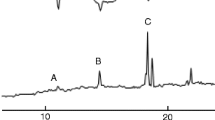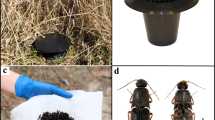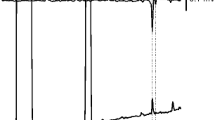Abstract
The sex pheromone of female dogwood borers (DWB) Synanthedon scitula (Harris) (Lepidoptera: Sesiidae) was determined to be an 88:6:6 ternary blend of (Z,Z)-3,13-octadecadienyl acetate (Z,Z-3,13-ODDA), (E,Z)-2,13-octadecadienyl acetate (E,Z-2,13-ODDA), and (Z,E)-3,13-octadecadienyl acetate (Z,E-3,13-ODDA) by gas chromatography–electroantennographic detection (GC–EAD) and gas chromatography–mass spectrometry (GC–MS). The major sex pheromone component, Z,Z-3,13-ODDA, was attractive as a single component. A blend of Z,Z-3,13-ODDA with 1–3% of E,Z-2,13-ODDA (binary blend) was more attractive than the single component. A third component, Z,E-3,13-ODDA, was sometimes observed in GC–EAD analyses, and enhanced attraction to the binary blend in some field bioassays. Lures containing 1 mg of binary and ternary blends attracted 18 and 28 times more male DWB moths, respectively, than caged virgin females in field trials. Attraction was strongly antagonized by addition of as little as 0.5% of E,Z-3,13-octadecadienyl acetate (E,Z-3,13-ODDA). In a period of 12 wk in 2004, more than 60,000 males were captured in sticky traps baited with synthetic pheromone blends in six apple orchards in Virginia, West Virginia, and North Carolina. Lure longevity trials showed that ∼76% of the pheromone remained in rubber septum lures after 12 wk in the field.






Similar content being viewed by others
References
A. M. Agnello D. P. Kain (2002) ArticleTitleEvaluation of pheromone disruption in combination with insecticide application for control of peachtree borers N. Y. Fruit Q. 10 29–31
S. R. Alm R. N. Williams D. M. Pavuk J. W. Snow M. A. Heinlein (1989) ArticleTitleDistribution and seasonal flight activity of male grape root borers (Lepidoptera: Sesiidae) in Ohio J. Econ. Entomol. 82 1604–1608
J. C. Bergh T. C. Leskey (2003) ArticleTitleBiology, ecology, and management of dogwood borer in eastern apple orchards Can. Entomol. 135 615–635
J. C. Bergh T. C. Leskey A. Zhang (2004) ArticleTitleDiscrimination by male dogwood borer, Synanthedon scitula (Lepidoptera: Sesiidae), among traps baited with commercially available pheromone lures J. Econ. Entomol. 97 344–352 Occurrence Handle15154454
S. M. Braxton M. J. Raupp (1995) ArticleTitleAn annotated checklist of clearwing borer pests of ornamental plants trapped using commercially available pheromone lures J. Arbor. 21 177–180
J. A. Davidson S. A. Gill M. J. Raupp (1992) ArticleTitleControlling clearwing moths with entomopathogenic nematodes: The dogwood borer case study J. Arbor. 18 81–84
T. D. Eichlin W. D. Duckworth (1988) Sesioidea: Sesiidae B. Dominick (Eds) The Moths of America North of Mexico. Fascicle 5.1 Wedge Entomological Research Foundation Washington, DC 1–176
G. P. Engelhardt (1932) ArticleTitleBusiness proceedings of the eastern branch of the American Association of Economic Entomologists J. Econ. Entomol. 25 239–294
C. R. Gentry J. W. Snow (1984) ArticleTitleDisruption of mating by male lesser peachtree borers and peachtree borers in a pheromone permeated peach orchard J. Ga. Entomol. Soc. 19 350–356
D. George P. Mallery (2002) SPSS for Windows Step by Step: a Simple Guide and Reference EditionNumber4th edn. Allyn & Bacon Boston
Greenfield, M. D. 1978. Niche segregation of adult clearwing moths (Lepidoptera: Sesiidae) in Wisconsin, p. 38. Ph.D. thesis. University of Wisconsin, Madison
D. Kain R. W. Straub (2001) ArticleTitleStatus of borers infesting apple burr knots and their management in New York orchards N. Y. Fruit Q. 9 10–12
M. G. Karandinos J. H. Tumlinson T. D. Eichlin (1977) ArticleTitleField evidence of synergism and inhibition of the Sesiidae sex pheromone system J. Chem. Ecol. 3 57–64 Occurrence Handle10.1007/BF00988133
T. C. Leskey J. C. Bergh (2003) ArticleTitleA simple character for sex differentiation of pupae and pupal exuviae of the dogwood borer (Lepidoptera: Sesiidae) Fla. Entomol. 86 379–381
Leskey, T. C., Bergh, J. C., Walgenbach, J. F., and Zhang, A. 2005. Improved attractiveness and specificity of pheromone-baited traps for male dogwood borer, Synanthedon scitula Harris (Lepidoptera: Sesiidae). Environ. Entomol. in press
D. W. Marshall P. K. Andrews (1994) ArticleTitleTrends in Washington State's apple industry HortTechnology 4 1–16
J. R. McLaughlin J. H. Tumlinson J. L. Sharp (1977) ArticleTitleAbsence of synergism in the response of Florida lesser peachtree borer males to synthetic sex pheromone Fla. Entomol. 60 27–29
D. G. Nielsen F. F. Purrington J. H. Tumlinson R. E. Doolittle C. E. Yonce (1975) ArticleTitleResponse of male clearwing moths to caged virgin females, female extracts, and synthetic sex attractants Environ. Entomol. 4 451–454
D. G. Nielsen F. F. Purrington G. F. Shambaugh (1979) EAG and field responses of sesiid males to sex pheromones and related compounds J. W. Neal (Eds) Pheromones of the Sesiidae SEA, U.S. Dept. Agric. ARR-NE-6 Washington, DC 11–26
D. G. Pfeiffer J. C. Killian (1999) ArticleTitleDogwood borer (Lepidoptera: Sesiidae) flight activity and an attempt to control damage in ‘Gala’ apples using mating disruption J. Entomol. Sci. 34 210–218
D. G. Pfeiffer J. C. Killian E. G. Rajotte L. A. Hull J. W. Snow (1991) ArticleTitleMating disruption for reduction of damage by lesser peachtree borer (Lepidoptera: Sesiidae) in Virginia and Pennsylvania peach orchards J. Econ. Entomol. 84 218–223
H. Riedl R. W. Weires A. Seaman S. A. Hoying (1985) ArticleTitleSeasonal biology and control of the dogwood borer, Synanthedon scitula (Lepidoptera: Sesiidae) on clonal apple rootstocks in New York Can. Entomol. 117 1367–1377
L. E. Rogers J. F. Grant (1990) ArticleTitleInfestation levels of dogwood borer (Lepidoptera: Sesiidae) larvae on dogwood trees in selected habitats in Tennessee J. Entomol. Sci. 25 481–485
M. Schwarz J. A. Klun B. A. Leonhardt D. T. Johnson (1983) ArticleTitle(E,Z)-2,13-Octadecadien-1-ol acetate. A new pheromone structure for sesiid moths Tetrahedron Lett. 24 1007–1010 Occurrence Handle10.1016/S0040-4039(00)81588-9
J. W. Snow T. D. Eichlin J. H. Tumlinson (1985) ArticleTitleSeasonal captures of clearwing moths (Sesiidae) in traps baited with various formulations of 3,13-octadecadienyl acetate and alcohol J. Agric. Entomol. 2 73–84
Snow, J. W., Schwarz M., and Klun J. A. 1987. The attraction of the grape root borer, Vitacea polistiformis (Harris) (Lepidoptera: Sesiidae) to (E,Z)-2,13-octadecadienyl acetate and the effects of related isomers on attraction. J. Entomol. 371–374.
J. W. Snow D. T. Johnson W. L. Meyer (1991) ArticleTitleThe seasonal occurrence of the grape root borer, (Lepidoptera: Sesiidae) in the eastern United States J. Entomol. Sci. 26 157–168
J. H. Tumlinson (1979) The chemistry of Sesiidae pheromones W. Neal (Eds) Pheromones of the Sesiidae SEA U.S. Dept. Agric. ARR-NE-6 Washington, DC 1–10
J. H. Tumlinson C. E. Yonce R. E. Doolittle R. R. Health C. R. Gentry E. R. Mitchell (1974) ArticleTitleSex pheromones and reproductive isolation of the lesser peachtree borer and peachtree borer Science (Washington, D. C.) 185 614–616
J. Warner S. Hay (1985) ArticleTitleObservations, monitoring, and control of clearwing borer (Lepidoptera: Sesiidae) on apple in central Ontario Can. Entomol. 117 1471–1478
A. Zhang S. Polavarapu (2003) ArticleTitleSex pheromone of the cranberry blossom worm, Epiglaea apiata J. Chem. Ecol. 29 2153–2164 Occurrence Handle10.1023/A:1025646804797 Occurrence Handle14584682
A. Zhang S. Polavarapu (2004) ArticleTitleIdentification of a sex pheromone component for the blueberry leafminer Caloptilia porphyretica J. Chem. Ecol. 30 1531–1545 Occurrence Handle10.1023/B:JOEC.0000042066.77560.59 Occurrence Handle15537157
A. Zhang H. T. Facundo P. S. Robbins C. E. Linn SuffixJr J. L. Hanula M. G. Villani W. L. Roelofs (1994) ArticleTitleIdentification and synthesis of female sex pheromone of Oriental beetle, Anomala orientalis (Coleoptera: Scarabaeidae) J. Chem. Ecol. 20 2415–2427 Occurrence Handle10.1007/BF02033210
A. Zhang P. S. Robbins W. S. Leal C. E. Linn SuffixJr M. G. Villani W. L. Roelofs (1997) ArticleTitleEssential amino acid methyl esters: major sex pheromone components of the cranberry white grub Phyllophaga anxia (Coleoptera: Scarabaeidae) J. Chem. Ecol. 23 231–245 Occurrence Handle10.1023/B:JOEC.0000006356.47959.ed
Acknowledgments
We thank Junying Nie of the USDA Chemicals Affecting Insect Behavior Laboratory (Beltsville, MD) for purifying synthetic pheromone components; Starker Wright and Torri Thomas of the USDA Appalachian Fruit Research Station (Kearneysville, WV), Jean Englemann of the Virginia Polytechnic Institute and State University (Winchester, VA), and Steve Schoof of North Carolina State University (Fletcher, NC), for technical assistance; and Dr. Tom Eichlin of the California Department of Food and Agriculture, Plant Pest Diagnostic Branch, California, for clearwing moth species confirmation and identification. We also thank West Virginia, Virginia, and North Carolina apple growers and horticultural societies. This work was supported in part by a grant from USDA-CSREES Southern Region IPM program. Mention of trade names or commercial products in this article is solely for the purpose of providing specific information and does not imply recommendation or endorsement by the U.S. Department of Agriculture.
Author information
Authors and Affiliations
Corresponding author
Rights and permissions
About this article
Cite this article
Zhang, A., Leskey, T.C., Bergh, J.C. et al. Sex Pheromone of the Dogwood Borer, Synanthedon scitula. J Chem Ecol 31, 2463–2479 (2005). https://doi.org/10.1007/s10886-005-7113-0
Received:
Accepted:
Published:
Issue Date:
DOI: https://doi.org/10.1007/s10886-005-7113-0




